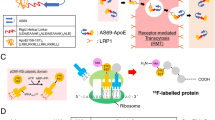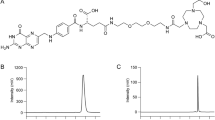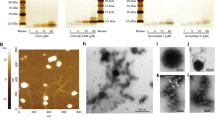Abstract
The very high binding affinity of avidin to biotin is one of the highest to occur in nature. We constructed a fusion protein composed of avidin and the endocytotic LDL receptor in order to target biotinylated molecules to cells of the desired tissues. In addition to the native avidin, charge-mutated and nonglycosylated avidins were utilized as part of the fusion proteins, in order to modify its properties. All of the fusion protein versions retained the biotin-binding capacity. Although the specificity was not increased, however, fusion proteins composed of natural avidin and nonglycosylated avidin bound most efficiently to the biotinylated ligands. Fluorescence microscopy and atomic force microscopy studies revealed the expression of the fusion protein on cell membranes, and demonstrated specific and high-affinity binding of biotin to the low-density lipoprotein receptor (LDLR)–avidin fusion protein in vitro. Additionally, systemically administered biotinylated ligand targeted with high specificity the intracerebral tumors of rats that were expressing fusion protein after the virus-mediated gene transfer. These results suggest that local gene transfer of the fusion protein to target tissues may offer a novel tool for the delivery of biotinylated molecules in vitro and in vivo for therapeutic and imaging purposes.
This is a preview of subscription content, access via your institution
Access options
Subscribe to this journal
Receive 12 print issues and online access
$259.00 per year
only $21.58 per issue
Buy this article
- Purchase on Springer Link
- Instant access to full article PDF
Prices may be subject to local taxes which are calculated during checkout






Similar content being viewed by others
References
Wilchek M, Bayer EA . Introduction to avidin–biotin technology. Methods Enzymol 1990; 184: 5–13.
Breitz HB et al. Clinical optimization of pretargeted radioimmunotherapy with antibody–streptavidin conjugate and 90Y-DOTA-biotin. J Nucl Med 2000; 41: 131–140.
Penichet ML et al. An antibody–avidin fusion protein specific for the transferrin receptor serves as a delivery vehicle for effective brain targeting: initial applications in anti-HIV antisense drug delivery to the brain. J Immunol 1999; 163: 4421–4426.
Axworthy DB, Reno JM, Hylarides MD et al. Cure of human carcinoma xenografts by a single dose of pretargeted yttrium-90 with negligible toxicity. Proc Natl Acad Sci USA 2000; 97: 1802–1807.
Green RM . Avidin. Adv Protein Chem 1975; 29: 85–133.
Subbiah K et al. Comparison of immunoscintigraphy, efficacy, and toxicity of conventional and pretargeted radioimmunotherapy in CD20-expressing human lymphoma xenografts. J Nucl Med 2003; 44: 437–445.
Boerman OC, van Schaijk FG, Oyen WJ, Corstens FH . Pretargeted radioimmunotherapy of cancer: progress step by step. J Nucl Med 2003; 44: 400–411.
Hnatowich DJ, Virzi F, Rusckowski M . Investigations of avidin and biotin for imaging applications. J Nucl Med 1987; 28: 1294–1302.
Pardridge WM, Boado RJ, Buciak JL . Drug delivery of antisense oligonucleotides or peptides to tissues in vivo using an avidin–biotin system. Drug Delivery 1993; 1: 43–50.
Shin SU et al. Functional and pharmacokinetic properties of antibody–avidin fusion proteins. J Immunol 1997; 158: 4797–4804.
Shi N, Boado RJ, Pardridge WM . Antisense imaging of gene expression in the brain in vivo. Proc Natl Acad Sci USA 2000; 97: 14709–14714.
Kassis AI, Jones PL, Matalka KZ, Adelstein SJ . Antibody-dependent signal amplification in tumor xenografts after pretreatment with biotinylated monoclonal antibody and avidin or streptavidin. J Nucl Med 1996; 37: 343–352.
Klibanov AL et al. Blood clearance of radiolabeled antibody: enhancement by lactosamination and treatment with biotin–avidin or anti-mouse IgG antibodies. J Nucl Med 1988; 29: 1951–1956.
Yamamoto T et al. The human LDL receptor: a cysteine-rich protein with multiple Alu sequences in its mRNA. Cell 1984; 39: 27–38.
Penichet ML, Morrison SL . Antibody–cytokine fusion proteins for the therapy of cancer. J Immunol Methods 2001; 248: 91–101.
Banerjee SK et al. Over expression of vascular endothelial growth factor and its receptor during the development of estrogen-induced rat pituitary tumors may mediate estrogen-initiated tumor angiogenesis. Carcinogenesis 1997; 18: 1155–1161.
Sato Y et al. In vivo gene delivery to tumor cells by transferring–streptavidin–DNA conjugate. FASEB J 2000; 14: 2108–2118.
Paganelli G et al. In vivo labelling of biotinylated monoclonal antibodies by radioactive avidin: a strategy to increase tumor radiolocalization. Int J Cancer Suppl 1988; 2: 121–125.
Di CV et al. Preoperative and intraoperative radioimmunodetection of cancer pretargeted by biotinylated monoclonal antibodies. Semin Surg Oncol 1998; 15: 235–238.
Paganelli G et al. Antibody-guided three-step therapy for high grade glioma with yttrium-90 biotin. Eur J Nucl Med 1999; 26: 348–357.
Corti A et al. Tumor targeting with biotinylated tumor necrosis factor alpha: structure–activity relationships and mechanism of action on avidin pretargeted tumor cells. Cancer Res 1998; 58: 3866–3872.
Guttinger M et al. Adoptive immunotherapy by avidin-driven cytotoxic T lymphocyte-tumor bridging. Cancer Res 2000; 60: 4211–4215.
Xu X et al. Targeting and therapy of carcinoembryonic antigen-expressing tumors in transgenic mice with an antibody–interleukin 2 fusion protein. Cancer Res 2000; 60: 4475–4484.
Grana C et al. Pretargeted adjuvant radioimmunotherapy with yttrium-90-biotin in malignant glioma patients: a pilot study. Br J Cancer 2002; 86: 207–212.
Paganelli G, Malcovati M, Fazio F . Monoclonal antibody pretargetting techniques for tumour localization: the avidin–biotin. Nucl Med Commun 1991; 12: 211–234.
Marttila AT et al. Recombinant neutralite avidin: a non-glycosylated, acidic mutant of chicken avidin that exhibits high affinity for biotin and low non-specific binding properties. FEBS Lett 2000; 467: 31–36.
Laitinen OH et al. Biotin induces tetramerization of a recombinant monomeric avidin. A model for protein–protein interactions. J Biol Chem 2001; 276: 8219–8224.
Lehtolainen P et al. Cloning and characterization of scavidin, a fusion protein for the targeted delivery of biotinylated molecules. J Biol Chem 2002; 277: 8545–8550.
Penman M et al. The type I and type II bovine scavenger receptors expressed in Chinese hamster ovary cells are trimeric proteins with collagenous triple helical domains comprising noncovalently associated monomers and Cys83-disulfide-linked dimers. J Biol Chem 1991; 266: 23985–23993.
Olkkonen VM et al. Expression of exogenous proteins in mammalian cells with the Semliki Forest virus vector. Methods Cell Biol 1994; 43: 43–53.
Bayer EA, Ehrlich RS, Wilchek M . Sodium dodecyl sulfate–polyacrylamide gel electrophoretic method for assessing the quaternary state and comparative thermostability of avidin and streptavidin. Electrophoresis 1996; 17: 1319–1324.
Punnonen EL, Marjomäki VS, Reunanen H . 3-Methyladenine inhibits transport from late endosomes to lysosomes in cultured rat and mouse fibroblasts. Eur J Cell Biol 1994; 65: 14–25.
Griffiths G, Matteoni R, Back R, Hoflack B . Characterization of the cation-independent mannose 6-phosphate receptor-enriched prelysosomal compartment in NRK cells. J Cell Sci 1990; 95: 441–461.
Lehenkari PP, Charras GT, Nykanen A, Horton MA . Adapting atomic force microscopy for cell biology. Ultramicroscopy 2000; 82: 289–295.
Hutter JL, Bechhoefer J . Calibration of atomic-force microscope tips. Rev Sci Instrum 1994; 64: 1868–1873.
Lehenkari PP, Horton MA . Single integrin molecule adhesion forces in intact cells measured by atomic force microscopy. Biochem Biophys Res Commun 1999; 259: 645–650.
Marjomaki VS et al. Lysosomal trafficking in rat cardiac myocytes. J Histochem Cytochem 1990; 38: 1155–1164.
Sandmair AM et al. Herpes simplex virus thymidine kinase gene therapy in experimental rat BT4C glioma model: effect of the percentage of thymidine kinase-positive glioma cells on treatment effect, survival time, and tissue reactions. Cancer Gene Ther 2000; 7: 413–421.
Acknowledgements
This study was supported by the Finnish Academy, Kuopio University Hospital (EVO grant) and Ark Therapeutics Ltd. We thank Ms Piia Valonen MSc, Ms Irene Helkala, Ms Aila Erkinheimo, Ms Mervi Nieminen and Ms Seija Sahrio for the technical assistance, and Ms Marja Poikolainen for preparing the manuscript.
Author information
Authors and Affiliations
Rights and permissions
About this article
Cite this article
Lehtolainen, P., Wirth, T., Taskinen, A. et al. Targeting of biotinylated compounds to its target tissue using a low-density lipoprotein receptor–avidin fusion protein. Gene Ther 10, 2090–2097 (2003). https://doi.org/10.1038/sj.gt.3302120
Published:
Issue Date:
DOI: https://doi.org/10.1038/sj.gt.3302120



